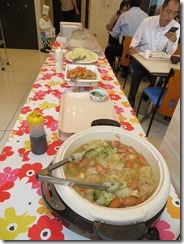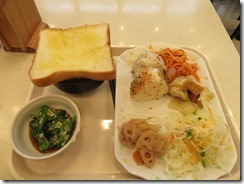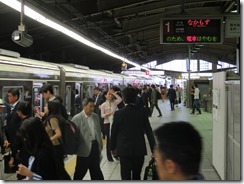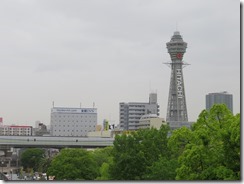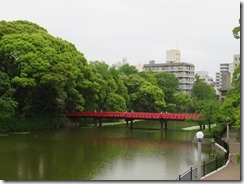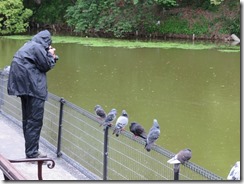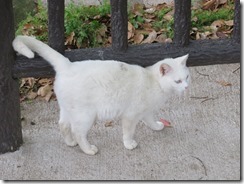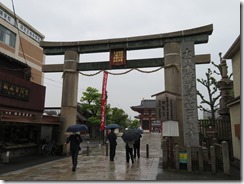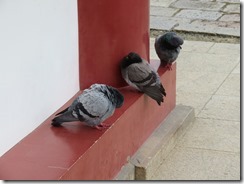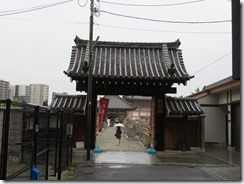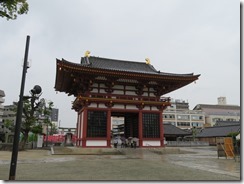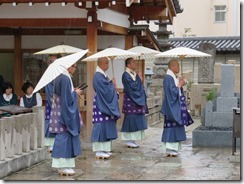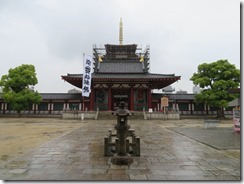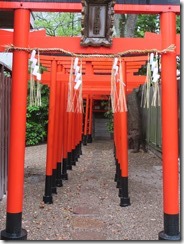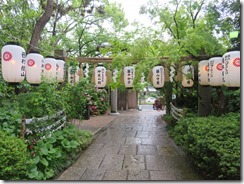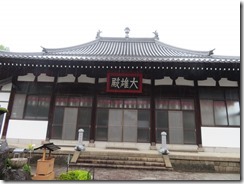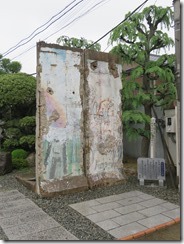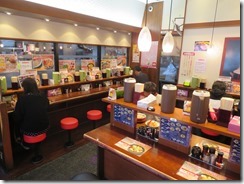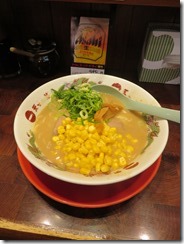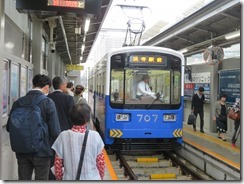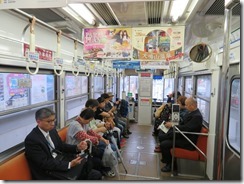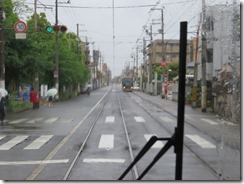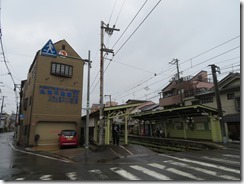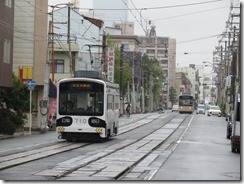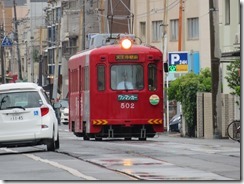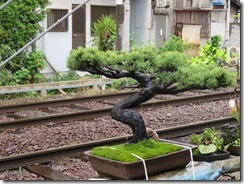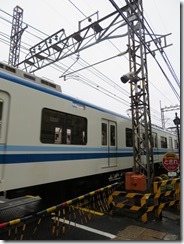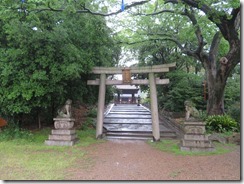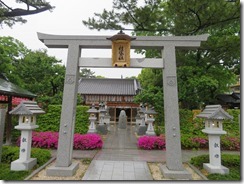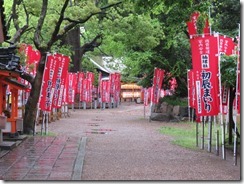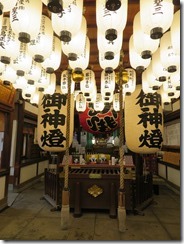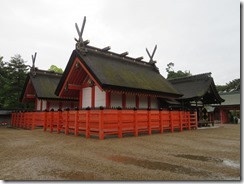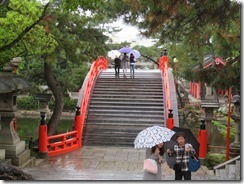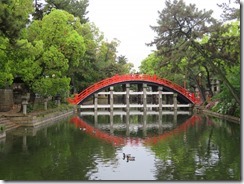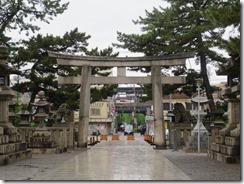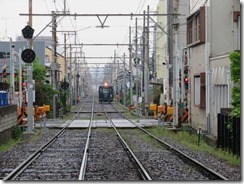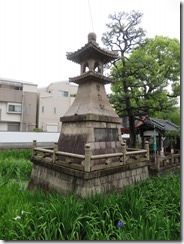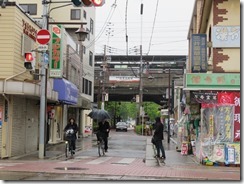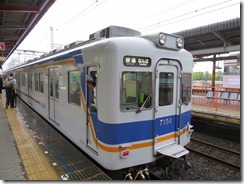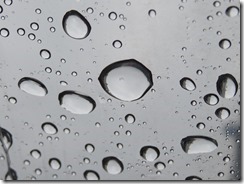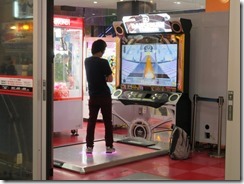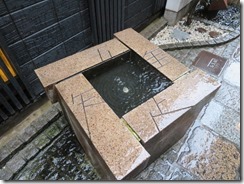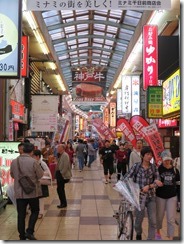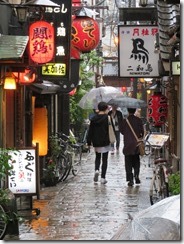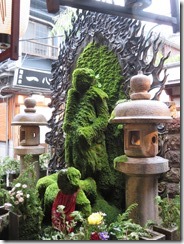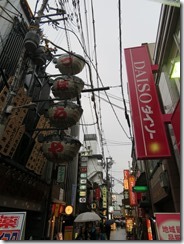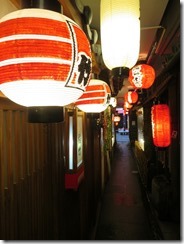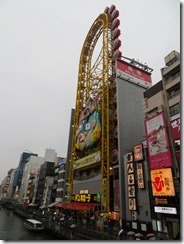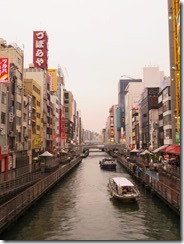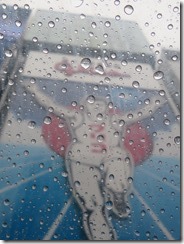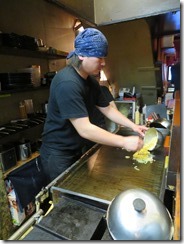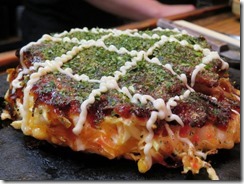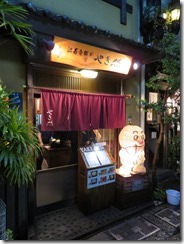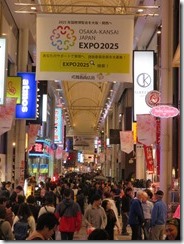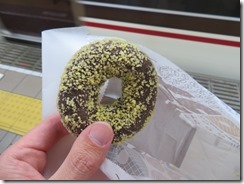Some Japanese place names are quite a bit of fun. Or, at least to me. There’s one train station near us named Nishinakajima-Minamigata Station. That particular mouthful of a name means “West Central Island, Southern Side”. One wonders how many other directions can get worked into that.
Osaka is the capital and largest city in Osaka Prefecture, and the second largest in Japan, with a population of over nineteen million. Oddly, during the night, it falls back to only third largest, because a fair percentage of the people who work in Tokyo live in Yokohama, meaning Yokohama overtakes Osaka in population when the workforce goes home. Osaka means “large hill”, but it used to be spelt with different kanji, but during the Meiji Restoration, people realised that when the second kanji was read as two separate kanji, it means “samurai rebellion”, so they changed it.
Today we started with breakfast, as usual, though there was a comparatively extravagant spread available, I thought.
Then we headed out for sightseeing. First step was to take the Osaka Municipal Subway Midosuji Line to Tennoji Station. Originally this was just intended as a place where we change trains, but quite recently – as in, just a few days ago – I discovered that Shitenno-ji, a Buddhist temple generally regarded as being the first in Japan, is in the area. In fact, Tennoji station takes its name from the temple.
Sadly, and as predicted by the iOS Weather app, it started to rain as we started walking away from Tennoji Station, and didn’t let up at all for the remainder of the day. Fortunately not pounding, driving rain, but still an annoying all-day shower.
We started our stroll walking in the wrong direction – somehow I’d gotten the idea that the Midosuji Line runs north-south at Tennoji, because that’s what it does at Shin-Osaka, but actually it runs east-west. But the upside of that was that had a lovely stroll through Tennoji Park, and got a nice view of Tsutenkaku (essentially Osaka’s equivalent of Tokyo Tower or Kyoto Tower).
As we left the park, a random person popped out of a house (or shop?) and handed James an umbrella – I had my el cheapo plastic one from the convenience store, but James was just in his raincoat and waterproof pants, so perhaps the guy took pity on him. Although it was a raincoat, the general effect of it is that he was looking a bit damp.
Soon, we reached Shitenno-ji and had a bit of a look around. The temple was founded in the year 593, though most of the present buildings are reconstructions dating from 1963. According to my Lonely Planet guidebook, though, there’s a stone torii dating from 1294, making it one of the oldest in Japan (though while I photographed it, I didn’t specifically notice it at the time). The temple’s name means “Four Celestial Kings”.
We arrived in time to see a group of monks performing some kind of ceremony in front of some of the minor side temples. We looked around at more things, but the main courtyard cost money to enter (and appeared to be half under refurbishment), so we decided to pass on that. I found the goshuin office, and discovered they had twenty-three different goshuin on offer. Not even sure what most of them mean. I got two of them and left it at that.
Heading back towards the station, we popped into a small shrine and temple. The shrine was Horikoshi Shrine – I mostly popped in here because I’d mistaken it for the temple we went to after, but it turned out to be a very nice-looking shrine. Seemed they were also one station on a stamp rally commemorating the Summer War of Osaka back in 1615 – recall that Osaka Castle is also a museum about this war, but they were commemorating it here because Tennoji was the site of the war’s final battle. Turned out Shitenno-ji also had a stamp, according to a poster in the window here, but I hadn’t noticed at the time, and we weren’t about to go back for it.
The temple we visited was Tokoku-ji, and I found it notable because they have an actual piece of the Berlin Wall – and by “piece”, I mean a full-height section of the wall about two metres wide. I’d spotted it as a point of interest in Pokémon Go, so we basically just popped in, took some photos, and popped out again. Incongruously, considering it’s a temple, the road leading up to the gate is lined with love hotels (for those who’ve never heard of love hotels, I’ll just say they rent rooms by the hour, and leave it at that).
Back at Tennoji Station, we decided to stop for lunch – ramen. Specifically, ramen at Tenka Ippin, a chain of ramen restaurants whose kotteri soup base I’d heard many great things about. We both ordered kotteri ramen, James with won tons and me with corn, and it was so very tasty.
From there, we hopped onto the Hankai Tramway, a little light rail that was constructed in 1900 and is still running. With all the rain, though, the windows all fogged up making it a little tricky to take photos. Our target was Sumiyoshi Taisha shrine, but I wanted to hop off a couple of stops early – I’ve been working on creating subtitles for a live-action Japanese drama as a hobby, and several scenes were filmed at and around Tezukayama-yonchōme Station on the Hankai Uemachi Line, which is just a few stops short of Sumiyoshi.
I went for a bit of a wander around the place, while James headed straight for the shrine. It was very interesting seeing the locations for myself in person. I’d vaguely hoped to find the house where the series’ characters live, but there’s no reason that it’s anywhere nearby – or, for that matter, that it even exists in the real world. They’re certainly vague enough about how places relate to each other in the series – one early episode has one character point vague directions to Tsutenkaku and Osaka Castle, but the positioning of her arms describes an area of Osaka that’s nowhere near the Hankai Line.
Snooping done, I made my own way to Sumiyoshi Taisha. I found an “all drinks 100 yen!” vending machine, so I bought a melon cream soda to use up my ten-yen coins and slurped on it as I walked. Spent a while poking through what I’d taken to be some minor temples and shrines I’d seen on the map north of Sumiyoshi, but when James messaged me to ask where I was, I discovered on looking at the map that I’d actually been skulking around the inner courtyards of Sumiyoshi itself.
Sumiyoshi is one of the earliest shrines in Japan – its construction pre-dates the arrival of Buddhism in the country, and more importantly, Buddhist architectural styles. Basically, it was built in an entirely Japanese style, and it’s the ur-example of what is now called “sumiyoshi-zukuri”, or “sumiyoshi style”.
It’s quite an expansive shrine, though, with buildings all over, and a sharply curving bridge that you could actually walk up and over (unlike other bridges of that style that I’ve seen). Rained throughout, though – and both of us were rapidly discovering precisely how waterproof our shoes are.
Once we’d seen the shrine, we headed to the nearby Sumiyoshitaisha Station on the Nankai Main Line for our third train trip – and our third railway company for the day – to get back to Namba Station in central Osaka. The Namba district contains the Dotonbori canal – views along which are some of the most-often used shots in travel ads – and lots and lots of shopping streets, the largest of them mercifully covered over. Last time, we clean missed visiting actual central Osaka, so I thought I’d rectify that this time.
James and I parted ways again and wandered up and down separately for a while. The first thing I wanted to see was Houzen-ji Temple – a tiny little temple which is little more than a courtyard to one side of a back alley. It has a statue of Fudo which is entirely covered in moss, thanks to the practice of splashing water over it as a means of worship. Wandered a bit more after that, before meeting up again with James and heading to dinner.
On our last visit in Osaka, I made several attempts to get Osaka-style okonomiyaki (Japanese savoury pancake/pizza thing, name means “cooked as you like it”) but was never able to find any restaurant near our hotel, so this time I wasn’t going to be leaving without getting some. Fortunately, I managed to find a nice looking little restaurant on my wanderings, so we headed into there. It was most tasty. The chef cooks it sort of it front of you, then it’s served on smaller versions of the big hot plate that are kept hot when not in use.
After dinner, we dropped by Bic Camera so I could, out of some desperation, buy a new external battery for my phone – I’m getting a bit tired of them running flat in the early evening or even mid-afternoon. Not entirely sure how the prices compared to Australia.
Then, since it had become full night, we headed to see the lights of Dotonbori. Very shiny. Very crowded. Still raining.
Headed back to the hotel by the Midosuji Line again. I’d been vaguely hoping to make it four companies for four trips, but while there is a JR station at Namba, it’d require multiple transfers to get back to our hotel using JR only, so Osaka Subway it was. I grabbed a donut from Mister Donut for dessert, trying to go for something fairly uniquely Japanese (though not quite so uniquel Japanese as matcha and red bean paste). Got a “golden chocolate” one (though still not sure what the golden bits were made of) and wound up costing me less than I expected – maybe end-of-day sales.
Back at the hotel, I did a bit more laundry while blogging. Wound up not actually getting all that soaked in the end, though it was mostly just annoying having to shield the camera from the rain. I did quite like the transparent umbrella, though – not too sure why they’re not a thing in Australia.
Tomorrow is also forecast to rain, but that doesn’t matter so much, since we’ll be travelling back to Tokyo. Thursday and Friday have no rain predicted.
Today’s photo count: Six hundred and eighty-five.
Today’s pedometer count: 22,347 steps, for 15.5km
Today’s goshuin count: Five. Two from Shitenno-ji (the second one refers to one of the Seven Lucky Gods, though I’ve clean forgotten which), then Horikoshi Shrine (a little plainer than I would have liked), Sumiyoshi Taisha, and Houzen-ji.
Today’s stamp count: Just the one from Horikoshi. It shows Tokugawa Ieyasu, the first Tokugawa shogun, and commander of the attacking forces in the Summer War of Osaka.

